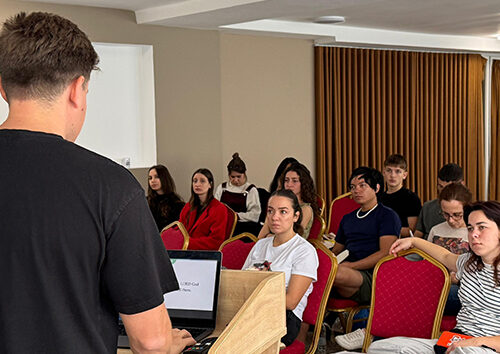15 March 2024, Bracknell, UK [Steve Currow]
Information overload! Snaps, texts, emojis, likes, prods and hashtags. But is it chat or just chatter? Social media in the digital age has left us overwhelmed. So many apps and platforms from which to choose. So many ways to communicate instantly to so many people, all at once. But is anyone listening?
Communication theory talks about senders, receivers, media, messages and feedback. A sender encodes a message which is sent via media to a receiver who decodes the message and responds with encoded feedback re-sent via media to the initial sender who decodes it. Behind this theory, Aristotle, in ancient Greece, noted three key components of communication: Ethos, Pathos and Logos.
Logos
Let’s discuss the last one first, as this is usually all we think about when we want to communicate. Logos is the information part of the communication, the message. It can be all the snaps, texts, emojis, tweets and hashtags that we use. It can be colourful, creative, dramatic, provocative and profound. However, according to Aristotle, logos without pathos and ethos is just superficial chatter and not communication.
Pathos
Pathos is the ability to feel. We get words like sympathy and empathy from this Greek root. Aristotle believes that effective communicators also need to feel with and for their audience, the receiver. It’s about compassion. This means we need to enter their world or walk in their shoes. My choice of the information I send, as well as the media I use, should reflect my empathy for the person with whom I am trying to communicate. If my communication is going to be relevant to them, I need to demonstrate an understanding of what is going on in their world and how they think and feel. But even with pathos and logos, Aristotle would still question whether this was communication.
Ethos
Ethos is the credibility I, the sender, bring to the communication. It is not just the face I present or the mask I wear, but the person I am ordinarily. It is about authenticity. Is who I am and what I do consistent with what I am saying? Do I have the expertise and authority to say what I want to say? Only when ethos, pathos and logos align would Aristotle say we have real communication. This is true, whether we are the sender or the receiver, the communicator or the communicatee.

Jesus, as the Master communicator, demonstrated these three principles in his life and ministry here on earth. His authority came from who he was – God in human form. His daily habits and behaviour aligned with this persona. People were attracted to him because they could see he was a good teacher, with authenticity and credibility. His life demonstrated beyond doubt his ability to enter the world of his audience. His whole sojourn on earth, the incarnation, was God living amongst humanity, like us.
The use of parables in his teaching also demonstrated great empathy with his audience. He used things in their everyday life, things they knew and understood, to ensure that his communication was relevant and effective. He knew his audience so well that each of the different groups in the same crowd would get the message they needed without boring the other groups present. Who Jesus was, and his ability to empathise with his audience, provided the necessary foundations for his audience to receive the information Jesus was sharing clearly and concisely. It was his ethos and pathos which attracted people to hear what Jesus had to say and enabled them to decide to become his disciples.
So how do we apply the methods of Jesus in the new digital age of the internet and social media? How do we become authentic communicators with credibility and compassion for our audience in an age of information overload? It seems in our exuberance and haste to click send or share and update our status to the world, little thought is given to the ethos and pathos of our communication. As the sender: maybe we need to click the pause button, before the instant replay, and think about who we are and what our communication is saying about us.
Maybe we also need to click the pause button again and review our audience. Who are all these friends? What are their interests and needs? How can I frame my message in a way that all the audiences with whom I will share will understand what I mean? Will everyone who receives my thread, receive the message as I intended? Is the social media I am using the most appropriate way of communicating this message to this person?
Maybe we also need to think about the information. Does my communication reflect my interest in them, or just my opportunity to share about myself? Will this create superficial chatter or real chat?
As the receiver of all these searches, tweets and messages, we also need to think about these three principles. Is the sender posting the message trustworthy? Do they have the expertise, authority and authenticity to communicate on this topic? Are they relevant to me? Does their communication consider my context and demonstrate an understanding of my circumstances and life? Does their communication care about me or is it just chattering about them?
As Christians, we are called as ambassadors of Jesus. Like Jesus was God’s ambassador to this world, so are we. In this fast-paced life with so many opportunities to instantly communicate where we are, how we feel and what we think, let’s ensure that we, like Jesus, apply the principles of ethos, pathos and logos to all our threads and tweets. Then our chatter will be a real chat.
Steve Currow serves as the Principal of Newbold College of Higher Education.
[Photos: Shutterstock]



